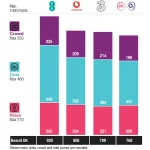Vorboss Criticises Ofcom Plan to Water Down Definition of UK Leased Lines

London-focused ISP Vorboss, which runs a 100Gbps speed fibre optic network in the UK’s capital city, has told Ofcom that reclassifying the UK’s market for high capacity leased lines to include “LeasedLine Equivalents” (LLEs), such as XGS-PON technology (underpins many FTTP broadband networks), would be “misguided, confusing, and ultimately detrimental“.
The industry regulator is currently in the process of conducting a major Telecoms Access Review 2026 (TAR), which reflects a wide-ranging market study that is typically only conducted every 5-years. The study is looking to make changes that “promote competition and investment” in gigabit broadband and business connectivity. But such things are always easier said than done, with vested interests frequently clashing.
Speaking of which, leased lines have historically been considered as private dedicated fixed lines, which offer guaranteed bandwidth and greater reliability via strong Service Level Agreements (SLA) to specific sites (point-to-point). But in recent years the increased roll-out of Fibre-to-the-Premises (FTTP) based broadband, which has narrowed the technology and performance gap, has started to muddy that debate (e.g. EoFTTP – Ethernet over FTTP).
Advertisement
On this front, one of the lesser-known parts of Ofcom’s proposals under the new TAR concerns its plan to broaden how they define the single product market for leased line access (LLA) services at all bandwidths (data speeds). Under the change, this would now include “leased line equivalent [LLE] services delivered over symmetric PON (e.g. XGS-PON)“, which is the same technology that underpins many consumer FTTP (full fibre) lines.
Extract from Ofcom’s TAR 2026 Consultation
We therefore provisionally conclude that services with features such as uncontended capacity, symmetric download and upload speeds, and quality of service parameters similar to point-to-point leased line services (e.g. fast repair times compared to WLA services) delivered over symmetric PON (such as XGS-PON) should be included within the LLA product market. We refer to these services as ‘leased line equivalent’ (LL-equivalent) services.
As with anything the regulator suggests these days, this idea isn’t universally popular, and business ISP Vorboss told ISPreview that they’ve expressed “serious concerns” over the redefinition. “While we appreciate Ofcom’s broader objectives of ensuring fair competition and encouraging investment, we strongly believe that this reclassification is misguided, confusing, and ultimately detrimental to both end customers and the business connectivity market,” said the provider’s regulatory submission.
Vorboss highlights several “fundamental and material differences” between point-to-point leased lines and Ethernet over symmetric PONs.
Vorboss – Examples of the Differences
These technologies are not substitutes from a technical, operational, or investment perspective. Including both in the same product market undermines these distinctions:
• Network Topology and Investment: Point-to-point leased lines are far more resource-intensive, requiring up to 100x more fibre per customer. The network architecture and build economics are entirely distinct from PON-based strategies, which share infrastructure across multiple users. Providers typically pursue one strategy or the other, not both.
• Bandwidth Capabilities: Leased lines can already support symmetrical services at 10Gbps, 100Gbps and beyond. In contrast, XGS-PON is fundamentally limited in both capacity and scalability. Current PON solutions do not support higher bandwidths, nor is there evidence of widespread provider plans to upgrade to future versions with such capabilities. This directly contradicts the increasing bandwidth demands of modern businesses.
• Contention and Performance: Unlike leased lines, PONs inherently introduce contention, which limits performance and reliability. Businesses requiring uncontended, high-performance connections cannot rely on PON-based services, which often fail to deliver even the advertised headline bandwidths in practice.
• Scalability and Upgrade Paths: Leased lines offer granular, customer-specific upgrades with minimal disruption. In PONs, any significant bandwidth upgrade necessitates area-wide infrastructure changes, reducing flexibility and responsiveness.
• Resilience and Redundancy: Business customers increasingly demand route diversity and power resilience. These requirements are practically impossible to meet using ethernet over symmetric PONs due to fixed routing and cabinet-based active equipment susceptible to environmental and physical risks.
• Customisation and Control: Leased lines allow bespoke route planning and deployment, enabling customers to tailor connectivity for operational or compliance needs. PON networks cannot accommodate such flexibility.
• Security Considerations: Leased lines provide a physically and logically isolated connection, offering higher levels of security. Ethernet over PON, by its nature, is shared and thus inherently less secure.
• Service Agreements and Reliability: Leased line SLAs reflect the premium nature of the service: guaranteed uptime, rapid repair times, and consistent performance. These are critical to business operations and are not truly replicable by PON services, even if nominal service terms are offered.
The key point above being that, by suggesting “equivalence” between these solutions, Vorboss says Ofcom “risks signalling to the market that the return on investment in genuine leased line infrastructure will be eroded or devalued“. In fairness, there has always been some inevitable impact on leased lines as the capabilities of consumer grade broadband have improved, which occurred with FTTC and now FTTP – particularly for smaller firms.
Advertisement
In addition some operators, like Netomnia, have already partly deployed 50G PON technology (50Gbps), with Cityfibre also considering 100G PON for the future – further narrowing the gap. The example given above for “bandwidth capabilities” is thus set to become increasingly debatable.
The fact that FTTP is such a significant enhancement on what has come before, which narrows the gap to leased lines, is ultimately at the root of why Ofcom feels a need to reclassify LLEs to include XGS-PON lines. But it’s also easy to see why this might upset and threaten operators like Vorboss, which are focused on selling a very modern high performance taken on point-to-point leased lines.
Vorboss are clearly concerned about a rise in providers promoting FTTP based “Ethernet” products, which they say could “artificially inflating the perceived level of competition” and dilute the meaning of Ethernet – opening the door to “misleading marketing from providers that may imply parity where none exists“.
The provider concludes its submission by urging Ofcom to reconsider its approach and “maintain a clear and distinct definition of leased line services” that excludes Ethernet over symmetric PONs. The regulator currently intends to publish their final decision in March 2026, although they’ll publish their semi-final proposals before that in order to allow time for consultation (probably before the end of this year).
Advertisement
Mark is a professional technology writer, IT consultant and computer engineer from Dorset (England), he also founded ISPreview in 1999 and enjoys analysing the latest telecoms and broadband developments. Find me on X (Twitter), Mastodon, Facebook, BlueSky, Threads.net and Linkedin.
« Openreach UK Restarts FTTP Broadband Build in Fuel Leak Hit Bramley























































Having learned nothing from “FTTC is fibre”, Ofcom seem determined to create another issue. They must have too little real work to do.
> uncontended capacity, symmetric download and upload speeds, and […] fast repair times
Hard to argue that description isn’t describing a leased line equivalent service. Nobody would argue that Openreach leased lines aren’t actually leased lines because e.g. they can’t easily be upgraded to 100 Gb/s.
Openreach leased lines EAD can be upgraded to 10G easily (and further to at least 16x 100G). All that happens is the engineers swap what’s at the end of the fibre, if you had a XGS-PON ‘LLE’ then they’d have to replace the fire run to even offer you 10G
Doesn’t that mean that most fibre to the premises products qualify as being “easily upgraded”? Even swapping from PON to P2P is just “engineers swap what’s at the end of the fibre” plus an NTE change.
the average leased line has constraints as well – when you go beyond the limits of the NTE (eg going from 1G to 2G) then the supplier would have to come out and replace it.
the other arguments also depend on how an operator intends to deploy. You could theoretically give someone their own PON to themselves and thus there is no “security” implication. You could put a few 1G “LLE” customers onto a 10G PON (or 10G on 50GPON, etc) and all of them would receive effectively uncontended service. The operator benefits from economies of scale and use of existing processes.
Resiliency and route planning are valid arguments but there will be a lot of potential leased line customers who don’t want or need it and would prefer the cost savings.
I guess it ultimately depends on who these “LLEs” are for. The most critical use cases probably won’t use it, but someone who has outgrown traditional “business broadband” might jump at it.
Hrm.
Network Topology and Investment: Point-to-point leased lines are far more resource-intensive, requiring up to 100x more fibre per customer. <<< Yes, but fibre is cheap and PON ports are considerably more expensive than PtP. When the maths was done building PON came out 5-10% less expensive than PtP I believe.
Contention and Performance: Unlike leased lines, PONs inherently introduce contention, which limits performance and reliability. <<< Leased lines have contention after the dedicated fibre and are then prioritised with a guaranteed bit rate. PON can replicate guaranteed bandwidth.
Resilience and Redundancy: Business customers increasingly demand route diversity and power resilience. << Okay, but businesses have to pay for that diversity. Most of them sold use whatever the route the operator wants to use. Some use active kit inside cabinets to do WDM they aren't all straight to an exchange. Cabinets should have power resilience.
Customisation and Control: << Agreed but I bet the vast majority of them don't exercise this customisation and control.
Security Considerations: Leased lines provide a physically and logically isolated connection, offering higher levels of security. << PON is encrypted on the fibre, PtP isn't. Both can be trivially tapped in the field. The vast majority of what's going on both is encrypted before it gets to the NTE/ONT. A property on the same PON cannot tap others' upstream due to signal loss without tapping fibre, can't sniff via connection to a CBT port. Both likely take exactly the same fibre out of the exchange.
Service Agreements and Reliability: Leased line SLAs reflect the premium nature of the service: guaranteed uptime, rapid repair times, and consistent performance. << PON can provide consistent performance, repair times can be rapid, uptime guarantees can be provided.
On the upgrade stuff BT offer two different products, one to 1G and one to 10G. To upgrade means replacing the NTE at the property, and whatever needs doing at the exchange.
Offering a LLE over PON isn't going to be fun though but if they can be a thing over microwave they can over PON.
I did the maths in 2012 and found pricing to be within 10% difference for PON Vs P2P, however these days the gap is far wider and today at approx 20%, this is mostly due to the fact that PON active kit has fallen massively in price while AE kit has not at all (at the 1G level) the good news on the AE side is we can now buy 10G switches for a similar price to 1G switches in 2012 so we can deliver 10G uncontended for that 20% increase in cost. Pricing compared to offering 2.5G on a xgs pon with 1:32 split.
A leased Line typically provides guaranteed bandwidth from the NNI to the customer site. 5-6 Hour Fault Fix. Compensation backed SLG’s.
If a service deployed on a PON network can satsify these things, then I don’t understand the issue. The deivery method becomes less of a problem. The UK previously had a two tier broadband and leased line market, with nothing plugging the vast gap between the pricing of the two alternatives. PON gives operators flexibility to offer these business grade services with better economics.
PON networks also provide flexibility of upgrade path from contended to multi-gig uncontended service, without a new install of a new bearer, providing better experience to ISP’s, MSP’s, VAR’s and their end users.
Perhaps, Tim Creswick, and his overengineered point-to-point architecture see risk in this change, as his network is currently over-specced and under-loaded, with the capital’s businesses choosing either legacy EAD tech, or alternative operators who have sensibly deployed PON architecture.
I’m with Vorboss on this – the ‘glorified FTTP’ lines and services are not the same as a proper Ethernet Service and really should not be lumped in as such – give them some other name if you must – but don’t pretend they’re the same or in any way ‘equivalent’
I’m curious. Full disclosure, almost my whole career has been in the leased line world, at home and abroad, across multiple technology types from FDM channels and bearers, through PDH/SDH, Ethernet, MPLS, wavelengths, IRUs. I could go on.
Why isn’t it the same as a ‘proper’ Ethernet service? Nailed up bandwidth on a PON with a decent SLA is functionally equivalent to a leased line. What does an EAD from Openreach give me that differs?
The arguments against are red herrings. All of them.
The most popular resilience option in my kitbag was an EAD or local equivalent, backed up by a leased line equivalent FTTP circuit. Many customers have seen, correctly, that the backup was exactly as reliable and as available as the main circuit and are now perfectly happy to use them as primaries, with cellular or satellite failover.
I think to be honest leased lines were overused for a long time due to the ‘availability’ point, e.g if my office of 8 people needed a connection the choice was between say 9Mb ADSL (if I was lucky), 45Mb/11Mb FTTC or 100/100 leased line then they chose the leased line. If they’d of been able to buy 100/50 fttp then they’d of chosen that.
We forced a whole bunch of SMBs who didn’t need leased lines onto them because of lack of FTTC/FTTP availability so the average LL customer probably would of been happy with FTTP. The real users of leased lines say offices with 20+ employees at a location, hotels, phone masts, shopping centres are clearly not OK with a FTTP delivered service and often wouldn’t have it available anyway..
Vorboss is 100% spot on.
If you live / your office is in an FTTP area, you get a leased line because you want an SLA and 1:1 contention. You don’t get those things on GPON/XGS-PON. This is Ofcom/ASA allowing people to call copper fibre because at some point it’s fibre all over again.
Uncontended and an SLA perfectly possible on PON.
I think you’re the first one to bring up GPON, and Ofcom expressly call out the requirement for “symmetric PON”. But XGS-PON… If a network sold, say, five connections each at a gigabit over XGS-PON, why couldn’t the network offer a SLA? There’s no contention at the PON level.
You can have nailed-up bandwidth on a PON with no contention.
I work for a small business, and would like something better than our existing FTTC.
But the cost of a leased line is prohibitive.
There must be some product that bridges the colossal price gap (also speed gap & SLA gap) between FTTC & Leased Line.
FTTP is not available.
The bridging product is FTTP, you just need to wait for it to come
I am with Vorboss, whilst I can see potential for what Ofcom are thinking, I have no trust in Ofcom redefining things for years they allowed isps to sell Coax and FTTC as fibre products on equal terms to FTTP.
One thing I haven’t read anyone talk about here is availability. You want an Openreach EAD 10Gbps delivered to a cowshed in the middle of a Scottish mountainside? Sure – there’s an install cost, but they’ll do it.
Altnets: “What’s a mountain? We are only live in one half of each of 2 villages in Oxford, but if you live there sure it’s £39.99/month for 100mbps (with CGNAT)”
Is a product defined only by what it delivers, though? Skodas and Porsches are both cars, both go 100Mph – a rose by any other name? Leased Line over Microwave is a good point.
Maybe what’s needed then is a new name, like “Dedicated Small Business Internet” or some-such, putting the “LLe” type services in their place as “not quite as leased as leased-lines but a bit cheaper as a result of the compromise”?
The market will find its own equilibrium. Businesses / Business Owners understand their own sector in immense detail, but many don’t understand the technology at the level of *some* commenters here.
Business Owners want a solution to their problem. If a PON based service can provide the right solution to whatever that problem is, with the right SLA’s, Bandwidths etc, then PON vs. Point-to-Point is irrelevant.
Providers have been serving Ethernet over FTTC for years. Ethernet is a transmission standard, not a product. Ethernet was originally designed to be served over Co-axial cable, and has since been transmitted over many media, including CAT5/6/7/8, Point to Point Fibre, PON Fibre, Microwave, PowerLine etc.
Although “qualified” to enter this discussion, I am more concerned about the SLA/SLG inferences. A long time ago, two of my ex colleagues (one of whom has recently passed away) jointly authored a paper on the crap surrounding SLA/SLG. The focus should be on guarantees, as this paper argues with a good degree of engineering rigour which is sadly missing in all SLA/SLG discussions. See https://bit.ly/34g2Zfy
In my experience, most SLAs are just marketing fluff and/or a pre-planned cost built into the life of the contract. If a provider has an outage they fix it, pay out (if the customer can be bothered to claim) and move on.
I was fortunate enough to work for a ‘big enough’ customer that we effectively wrote the SLAs before signing. The focus was not so much on service credits but introducing break clauses that allowed us to cancel the whole contract if the SLAs weren’t being met. Providers were typically much more interested in root causing recurring issues when there isn’t the cushion of seeing out the contract term.
I remember the same arguments when Ethernet replaced PDH/SDH leased line technology.
The simple fact is if the service and features are the same, and it is delivered over a newer technology then there is only going to be one winner.
PON is the access technology that provides the ability to create multiple products at a traffic engineering level that delivers easy upgrades compared to older technology. Plus, it is evolving higher speed and performance capability to also serve increasingly performance sensitive needs like 5G fronthaul.
Very strange position from Vorboss….looks like sour grapes
That’s the argument though isn’t it?
The products and services aren’t quite the same.
If I was to buy a share in a fleet of vehicles which might be speed limited if my neighbour was using one of the others, and it might take a week to fix I’d expect it to be cheaper.
If the vehicle was independent of all others, and it guaranteed a 5 hour fix (or a significant discount if that commitment wasnt met) then I’d expect to pay more.
I’m definitely a fan of keeping these as distinct offerings, and letting competition drive the price down.
But that’s the point. You can pay your provider for whatever SLA/SLG you want, regardless of last mile technology. And you can guarantee throughput on a PON – if you want 5Gbps nailed up bandwidth, that’s what you get. It makes no odds what your neighbours are doing. It’s functionally equivalent
I think Vorboss (and others) are missing the point of all of this noise.
When Ofcom consulted on the Telecoms Access Review they had a very narrow definition of Leased Lines – that being P2P networks. All altnets who use PON to deliver business ethernet services had to respond to say that their available B2B footprints were smaller (or non-existant) that in reality they really were.
This then messes up all the data gathering and importantly for the future, what the competitive landscape looks like – how many B2B providers there are in an exchange, whether Openreach still has SMP etc etc.
All that’s happening now is that Ofcom are clarifying that they also want to get data on leased line equivalents to ensure that they can accurately determine the competitiveness of an area to make the correct regulatory interventions.
The argument over whether PON is a real leased line or now is largely semantics – if a customer wants to buy the service they care about the speed, the SLAs, the service guarantees and the price; not whether the route to the exchange is uncontended or not.
I’m not sure the scope is that narrowly defined, personally.
I think that the challenge here is that technology is moving on (sometimes more quickly that the equivalent increase in demand). As this happens PON capabilities are getting much closer in terms of speed that was historically was only trusted by a P2P service. I’ve not had time to compare what’s happened vs what was forecast to happen through the period of the current market review – it sounds like a challenging forecast to make.
It feels to me that the different market definitions are actually more of a challenge than the scope; at least in terms of driving a different perspective depending on which part (or parts) of the market definition an operator is working in.
I’ve pulled a few more thoughts together here https://www.linkedin.com/posts/colinsneddon_tar26-ll-markets-activity-7361508939370270721-_UlJ?utm_source=share&utm_medium=member_desktop&rcm=ACoAAAAFdGoBGrHHbnjCUmnZv-LJcHvZJ0vN_Fw
If I’m a smaller customer in a market town I would expect there’s a chance I will have different demands than if I’m operating an office in central London.
Most of this is ‘above my pay grade’. So, … I realise LLs are probably a good money-spinner, but is there anything technical/practical stopping Vorboss expanding their business’s product range to include the proposed LLE and supply that to customers where it is more appropriate than a true LL?
I don’t see why telecom providers can’t use a PON fibre to carry an out of band DWDM channel in parallel with PON service; Another possible solution might be to use a VLAN within a symetric PON with dedicated bandwidth. Any service provided over a shared PON fibre wont be secure, so any large data sensitive customer will likely want a dedicated leased line. Any business who’s not concerned about SLA’s and guarenteed bandwidth would likely go for a system utilising a standard PON service, possibly using 4/5G as backup.
Business SLA’s are important to Enterprise and large customers; Anyone who’s worked in a Telecom Engineering role, will likely know that a 4 hour SLA means Engineering resource will be allocated in short order and will remain on the fault until it’s repaired.
Network Security 101 – Presume any asset you don’t have direct control over is compromised and encrypt your traffic prior to entering it. It’s why IPsec exists.
IPsec alone isn’t the be all and end all, otherwise they wouldn’t have developed technologies based on Quantum Key Distribution.
I didn’t say it was the be all and end all. I was simply pointing out that the security issue raised is a red herring because any customer concerned by interception will already be encrypting their traffic.
QKD’s entire point is to protect against someone tapping the fibre.
‘Another possible solution might be to use a VLAN within a symetric PON with dedicated bandwidth.’ PON takes care of dedicated bandwidth, VLANs irrelevant.
PON or PtP largely irrelevant to SLA.
‘I don’t see why telecom providers can’t use a PON fibre to carry an out of band DWDM channel in parallel with PON service’
The 18-24 dB of loss of optical budget from 5-7 splits at PON plus another one to connect the DWDM comes to mind as a big reason.
Given you must also use BiDi optics so regular duplex fibre WDM off the table you now need something high power to get through 50km worth of loss that is using custom wavelengths, so tuneable.
Cheaper to use spare fibre and splice a PtP.